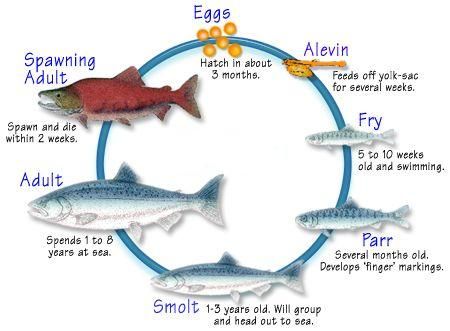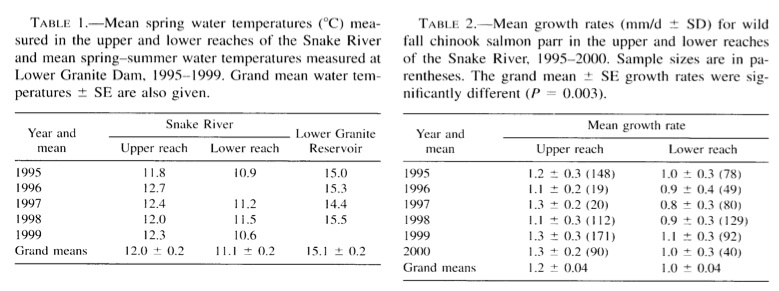MIGRATORY PATTERNS OF CHINOOK SALMON
Biology 342 Fall 2012
Tess Tumarkin & Erin McAllester
Ontogeny
Ontogeny is the history of individual development. With respect to migration, this page will focus on the internal development of migratory patterns and regulatory functions which keep migration patterns consistent for Chinook salmon.

We've established that Chinook Salmon migrate seasonally- and that specific conditions affect mortality rates for spawning salmon. But how do Chinook salmon know when the most optimal time to migrate is?
From the laying of the egg, to hatching, migration and finally spawning of the Chinook salmon, a path is determined at birth based on the place and time of birth. For those in the Snake River, in Idaho, we see a changing seasonal migration as a result of increased temperatures.

The tables above from Connor and Burge's paper on the growth of subyearlings in the fall Chinook salmon illustrates the correlation between temperature and speed of growth. This relationship is often linked to the seasonality of migration, as those that are born in warmer conditions (such as an especially hot summer) will develop more quickly according to Connor, and in turn, migrate earlier. This suggests that migration is not based merely on the time of year, but also on the age of the salmon and their internal assesment of the weather and environment around them.
Seasonal migration is heavily influenced by photoperiod. The circadian clock regulates hormone secretion in animals (and plants.) This circadian oscillator is powered by transcriptional activators and repressors generating a negative feedback loop. An essential activator for this feedback loop is the CLOCK transcription factor. By analyzing the variations in CLOCK, it has been deduced that a latitudal gradation exists, indicating that environmental factors may alter the CLOCK gene. This, in turn, suggests a gradiating response to latitude in Chinook salmon with respect to day length and seasonal change, and the expression of the CLOCK gene. (O'malley)